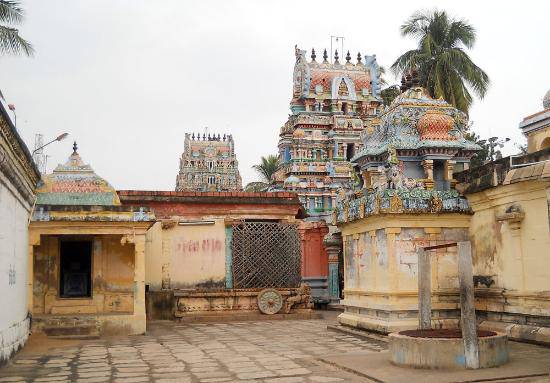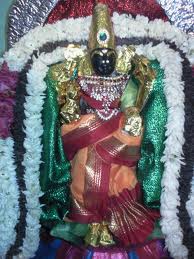
Are You Already Pregnant?
Pujas for safe pregnancy and easy delivery. The prasadam from Divine Mother Garbarakshambigai Amman will protect the expecting mother
Trying To Conceive?
There is hope for you. Thousands of people with infertility problems have been blessed with children by Garbarakshambigai Amman
Testimonials
Shanmuga Priya, USA
“In spite of trying hard and undergoing medical treatment, I could not conceive even after 7 years after marriage. I sent money to Janani Barath and she offered puja and sent me the prasadam. I had the prasadam for 48 days while chanting slokams daily. 1 month after taking the prasadam I conceived naturally without any treatment.” Thank you, Janani for helping me get the Grace of Divine and Mighty Mother.
Vinay Kumar, Canada
In the first month of her pregnancy. my wife had some complications. We prayed to the divine Mother Garbarakshambigai for help and offered puja through this website. There was an immediate change and things improved vastly. The rest of the course of the pregnancy was miraculously smooth and we had a normal delivery despite several complications. We are blessed with a lovely baby girl who has lit up our life.
Sadhana Jha, Japan
I’m happy to inform you that by the blessings of Goddess Garbarakshambika we are blessed with a baby boy on 5th January 2016. We’ve named our son ‘Saadhan Kowshik’, he was born in Swathi nakshatra, Tula Rasi.I wish to convey my heartful thanks to the temple in some way. Can you suggest a way to make some contribution? I’m visiting Bangalore now and can make an online payment. Thanks in advance!
Garbarakshambigai Amman Story and Prasadam Details
What is the speciality of Garbarakshambigai Temple?
The speciality of Garbarakshambigai Temple is that this temple is known to cure infertility and also ensure a safe pregnancy and normal delivery.
Goddess Garbarakshambigai Amman is widely revered as the foremost fertility deity in India, particularly in South India. Her divine powers are believed to bless couples with the gift of children, safeguard pregnancies, and ensure safe and easy deliveries. This powerful goddess is known to bless every aspect of childbearing, making her a significant deity for women trying to conceive and pregnant women seeking protection and support.
It is believed that childless people who worship here with devotion and faith are blessed with a pregnancy and pregnant women with safe deliveries. Unmarried women also pray here for their marriages. Special prayers are conducted by people on behalf of their pregnant relatives or friends.
Compassion, and divine presence is the nature of Garbarakshambigai Amman. Her radiance and grace are described as unparalleled, symbolizing her purity and benevolence. Devotees chant mantras and recite slokas dedicated to the goddess to invoke her divine presence and seek her protection and blessings.
It is believed that sincere devotion, unwavering faith, and regular worship of Goddess Garbarakshambigai can yield positive results and bring about the desired outcomes. The goddess’s benevolence and compassion are said to extend beyond the boundaries of physical fertility, encompassing the overall well-being and prosperity of her devotees.
How Do I Get Garbarakshambigai Ghee / Oil Prasadam?
We are here to offer pujas on your behalf. You can order puja online and get prasadam through us.
It is not always possible to travel to the temple to offer pujas, don’t worry we are here for you.
If you order a puja through us we will ensure that:
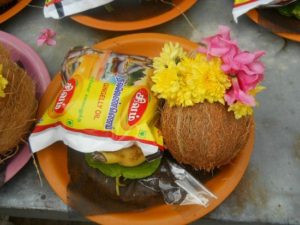
- A priest employed at the temple will personally perform your puja. All prescribed rituals will be followed at the time of performing pujas
- As the prasadam contains oil or ghee it needs to be packed carefully. We perform the puja at the temple and then take the prasadam to Chennai where we pack it using additional material. We laminate the plastic bottles that contain the prasadam and then pack it in a plastic box. This box is then wrapped and then sent to you.
- We are here to answer any query for yours and are always willing to help
- This service is especially useful to devotees staying aboroad in countries like USA, UK, Canada, Malaysia, Indonesia, Singapore, Dubai and other places where hindu devotees are present in large numbers.
- The prasadam rtakes 10-15 days to reach locations within India and 20-25 days to reach locations outside India
- We have been offering this service since 2011. We are pioneers in the field of performing puja and sending prasadam from various temples across India
You can book the prasadam through this website and we will get back to you with further details
Location of the Temple
Our temple is located in the fertile land of Thanjavur, also known as the ‘Rice Bowl of India.’ Specifically, it is situated in Papanasam taluk of Thanjavur district, 20 kilometers east of Thanjavur Town, and 20 kilometers southwest of Kumbakonam.
Address
The Executive Officer, Arulmigu Mullai Vananathar Thirukkoil, Thirukkarugavur (P.O), Papanasam Tk., Thanjavur Dt. 614 302
Temple Timings
The temple timings are from 5:30am – 12:30pm in the mornings and 4:00pm – 8:00pm in the evenings. The temple is open seven days a week. If there is a death of any person who lives in the 4 streets sorrounding the temple then the temple remains closed for a day.
When is a good day/time to visit the temple?
The specialty of this temple is that there is no specific day or particular time that is considered auspicious. It is good to visit the temple at any time or day as per your convenience. However, it is good to note that on weekends and other public holidays the temple can be crowded. Keep this in mind while planning your trip.
Certain festivals are celebrated like Navarathri, during Margazhimaasam and Karthigai maasam. These times can be considered extra special and there will be extra crowds at the temple.
How to reach the temple
By Air:
The nearest airport to the Garbarakshambigai Temple is Tiruchirapalli (Trichy) Airport, which is approximately 85 kilometers away. From Tiruchirapalli, one can hire a taxi to reach the temple.
If you plan to visit the temple a day after arriving in Tiruchirapalli, it is advisable to stay overnight either in Thanjavur or Kumbakonam before proceeding to the temple the next morning. Both Thanjavur and Kumbakonam offer excellent accommodation options. The temple is about 20 kilometers from both Thanjavur and Kumbakonam, and it takes approximately half an hour to reach the temple.
Various modes of transportation, including buses and autos, are available from Thanjavur and Kumbakonam to Thirukarukavur village in Papanasam District, where the temple is located.
By Train:
The nearest railway station to the Garbarakshambigai Temple is Papnasam, which is about 6.5 kilometers away. Alternatively, the railway stations of Thanjavur and Kumbakonam can also be used as destination stations. From both Thanjavur and Kumbakonam, the temple is approximately 20 kilometers away, and it takes around half an hour to reach the temple.
Similar to the options for traveling by air, various means of transportation, such as buses and autos, are available from Thanjavur and Kumbakonam to Thirukarukavur village in Papanasam District.
By Bus:
By Bus: If you plan to reach the Garbarakshambigai Temple by bus, here are the routes to follow:
- From Thanjavur to Thirukarukavur: Route Numbers – 16, 24, 34, and 44.
- From Kumbakonam to Thirukarukavur: Route Numbers – 11 and 29.
By Car:
If you are traveling by car, you can use the provided Google Maps route. Thirukarukavur is situated at the following coordinates: 10.86N, 79.27E. Smart phone users can utilize this information.
Additionally, auto-rickshaws and share autos are available from Papanasam Bus stop, with auto fares ranging from Rs. 60 to Rs. 80 and share auto fares ranging from Rs. 5 to Rs. 10.

Procedure for Visiting the Temple:
The temple operates from 5:30 am to 12:30 pm, and from 4:00 pm to 8:30 pm.
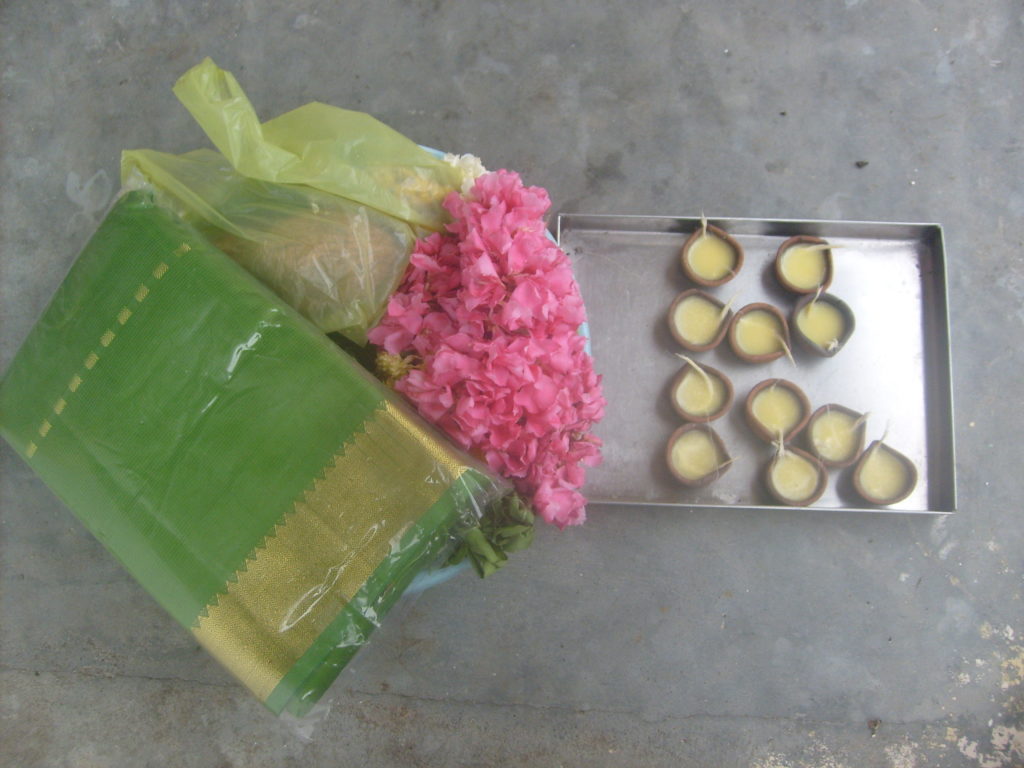
All the necessary puja items are available just outside the temple. Facilities are provided for Abishegam, placing children up to 5 years of age in the Golden Cradle, ear piercing, hair offering, and Thulabaram.
Arranging for any kind of puja is simple and straightforward. You won’t need any assistance. As a visiting couple or individual, you can offer pujas at any time during the temple’s opening hours. The duration of the puja can vary from 15 minutes to 2 hours, depending on the crowd. Sundays tend to be more crowded, so if you have limited time, it’s advisable to avoid visiting on Sundays. However, please note that every day is considered auspicious for puja in this temple; there are no specific days designated for offering pujas. Nevertheless, some devotees believe that offering pujas during the month of Margazhi increases the chances of conception.
Abishegam is performed only in the mornings from Monday to Saturday. There are no Abishegams in the evenings, on Sundays, or other festival days.
If you plan to offer a saree, please bring it with you. For Thulabaram, it’s recommended to contact the temple in advance to check availability.
What is the dress code for Garbarakshambigai Temple?
While traditional attire is encouraged for both men and women devotees, men wearing shirts and trousers are also permitted to enter the temple.
Women devotees can choose to wear either sarees or salwar kameez. During my visits, I have seen a few women wearing jeans and other Western attire, and the temple management does not seem to have a problem with this. However, it’s always better to err on the side of caution and dress in Indian attire.
If devotees are unable to travel, they can order the ghee or oil prasadam online.
If devotees cannot travel they can get the ghee or oil prasadam by ordering online
Some Additional Tips
- The approach road to the temple is in good condition, and the temple premises are clean and well-maintained.
- Ample parking facilities are available beside the temple.
- The cost of a puja basket with coconut, bananas, and flowers is approximately Rs. 180-250.
- There are no major restaurants in the vicinity. You can either have the Annadanam (free food distribution) at the temple or bring your own food. The temple Annadanam is tasty and highly recommended.
- Accommodation is available only in Kumbakonam or Thanjavur. There might be a few small lodges nearby, but no hotels.
- Fuel: Ensure that you have sufficient fuel when visiting this temple, as there are no petrol stations nearby. Petrol can be found in Papanasam, approximately 6 km away.
Different Ways to Offer Thanksgiving at the Temple:
Abishegam
Experience the sacred ritual of Abishegam, performed every morning except on Sundays and festival days. The Abishegam begins at 8:00 a.m., so make sure to arrive at the temple 30 minutes prior if you wish to participate.
Head Tonsuring and Ear Piercing
You have the opportunity to arrange for your baby’s hair tonsuring or ear piercing at the temple. Please inform the temple in advance to make the necessary arrangements.
Sandana Kaapu (Offering of sandalwood paste to Garbarakshambigai Amman):
Witness the enchanting sight of the Goddess adorned with fragrant sandalwood paste. This divine spectacle is most vibrant on Friday evenings when Amman’s beauty is further enhanced. If you would like to offer this service, you can do so by paying a charge of Rs. 5000 at the temple. Please contact the temple office for booking details.
Thulabharam
In accordance with the customs of major South Indian temples, devotees at Garbarakshambigai Temple can participate in Thulabharam. Sit on one side of the weighing scale while offering various items such as ghee, oil, food, grains, currency, gold, silver, and equivalent to your body weight on the other side. These offerings will be utilized by the temple administration. Surplus materials from Thulabharam are sold to devotees at subsidized rates during Sunday auctions.
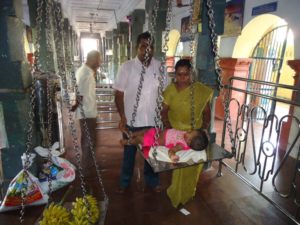
Thanga Thottil – Thanksgiving by Placing Baby in Golden Cradle
After the birth of their child, many couples visit the temple to express their gratitude and seek blessings. As a way of thanking the Goddess and seeking blessings for the child, parents can place their child, aged up to 5 years, in the Thanga Thottil (Golden Cradle) and take a round in the Garbarakshambigai Amman Praharam. The fee for placing the child in the cradle is Rs. 550 and can be paid at the office. This service is available in the morning and evening.
Please note that the Thanga Thottil is not made of actual gold but has a silver covering. Devotees are encouraged to return with their children and place them in the Thanga Thottil as a gesture of gratitude.
Video of Thanga Thottil
Lighting Lamps and Offering Saree to Amman
In this temple, people who pray for pregnancy, are advised to light up eleven lamps (one for Sri. Vinayagar, one for the Lord Mullaivananathar and nine for Almighty Sri. Garbarakshambigai) and who pray for safe delivery are advised to light 5 lamps (one for Sri. Vinayagar, one for the Lord Mullaivananathar and three for Almighty Sri. Garbarakshambigai).
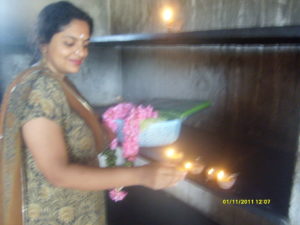
Feeding cows and goats in and around the temple
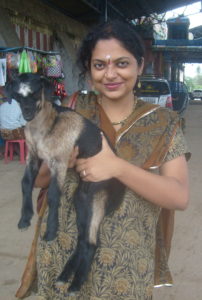
Offering Annadanam – the highest form of thanksgiving
Annadanam is one of the highest offerings according to Hindu philosophy. It is one of the best ways of expressing your gratitude to the divine.
The temple is situated in a small village where there are no big restaurants. The Temple offers Annadanam to 100 devotees on a daily basis.
If you are visiting the Temple then please part-take in the meal as it is a superior form of prasadam.
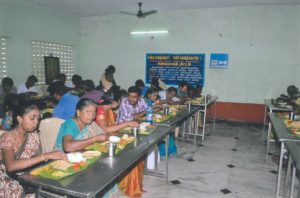
Puja Procedure for Ghee Prasadam and Instructions to Take Ghee Prasadam
The ghee prasadam is specially meant for couples who are trying to conceive.
When you visit the temple to receive the ghee prasadam, the process is simple and straightforward. First, you need to acquire the puja items and the ghee prasadam.
The puja items are available just outside the temple, while the ghee prasadam can be obtained from the counter near the administrative office inside the temple. Once you have these, you can proceed to have darshan of Lord Mulaivananathar. After offering your prayers at the Shiva sannidhi, you can then move on to the Amman sannidhi.
After completing the archanai, the priest will guide you to apply some ghee on the steps of the sannidhi.
The ghee prasadam you received will be placed at the feet of Amman and returned to you at the end of the puja.
As a further offering to Ambal, the couples can purchase ghee lamps from the counter outside and light 11 lamps.
If desired, couples can also make additional offerings at the temple such as Annadanam, Thulabaram, or hair tonsuring.
Upon returning home, the couple must consume the prasadam daily for a period of 48 days, following the instructions provided by the temple.
If a couple is unable to visit the temple in person, it is acceptable to receive the prasadam through a trusted individual.
During these 48 days, it is beneficial if the couple can recite the Garbarakshambigai mantras. Ideally, chant the mantras 108 times after the morning or evening puja. If time is limited, chant as many times as possible for you.
You can also listen to and download the audio songs of Garbarakshambigai Amman.
Please note that there are no specific rules for chanting the mantras. Simply chant them as you would any other mantra or sloka, either in the presence of Amman’s photo or by focusing on Amman’s divine presence in your mind.
You can read testimonials of people who have taken ghee prasadam here
You can order the ghee prasadam online here.
Puja Procedure for Oil Prasadam and Instructions for Using Oil Prasadam
The oil prasadam is specifically intended for pregnant women seeking a safe pregnancy and easy delivery.
When you visit the temple to receive the oil prasadam, the process is simple and straightforward. First, you need to obtain the puja items and the oil prasadam, which comes in a small bottle of castor oil.
The puja items can be found just outside the temple, while the oil prasadam is available inside the temple at the counter near the administrative office. Once you have them, you can proceed to have darshan of Lord Mulaivananathar. After offering your prayers at the Shiva Sannidhi, you can then move on to the Amman Sannidhi.
During the archanai, the priest will place your oil bottle at the feet of Amman and return it to you. Afterwards, couples can go outside and purchase ghee lamps from the counter to light 5 lamps as an offering to Ambal.
If desired, couples may also choose to make additional offerings at the temple such as Annadanam, Thulabaram, or hair tonsuring.
Typically, the oil prasadam is obtained during the 3rd trimester of pregnancy. If a woman is unable to travel during that time, she can arrange to receive the prasadam through other trustworthy individuals.
There are no food restrictions while taking the prasadam, so the woman can continue consuming non-vegetarian food. The complete set of instructions for using the oil prasadam is provided at the temple.
Throughout the pregnancy, it is beneficial for women to recite the Garbarakshambigai mantras. If time allows, chant the mantras 108 times after the morning or evening puja. If time is limited, chant as many times as you can manage.
You can also listen to and download the audio songs of Garbarakshambigai Amman. These powerful shlokas and songs have excellent vibrations for the well-being of your unborn child.
Please note that there are no specific rules for chanting mantras. Simply chant them as you would any other mantra or sloka, either in the presence of Amman’s photo or by focusing on Amman’s divine presence in your mind.
You can read testimonials of people who have taken oil prasadam here
You can order the oil prasadam online here.
What is Punugu Sattam and What is the Procedure for Punugu Sattam?
Punugu sattam is a kind of prasadam that is obtained from the shrine of Lord Mulaivananathar. The idol of Lord Mulaivananathar is situated at the temple of Garbarakshambigai Amman and Mulaivananathar Swamy in Thirukarukavur, Tamil Nadu.
The lingam in this temple is a Swayambu Lingam and was originally an ant hill (putthu). In order to keep this putthu or mud ant-hill Lingam protected, a paste of punugusattam is applied (a paste) on the Lingam. This mud paste is also applied in lieu of Abishegam. This paste is then scraped off and reapplied on the 11th day after the new moon. This day is also called the Valarpirai Pradosham. This scraped of punugusattam is offered to devotees as prasadam.
Punugu sattam is offered to devotees as prasadam for health conditions, particularly skin diseases, cardiac problems, and other surgical conditions. It is believed that people who suffer from incurable diseases come to the temple and offer Punugu Chattam to the Lord and get themselves cured of the disease.
Once devotees obtain the punugusattam they can apply small quantities on the affected parts of their bodies after taking a bath and offering puja at home.
Origin of the Temple:
Let’s transport ourselves back thousands of years to a time when ancient sages and mystics thrived in India, and extraordinary miracles were a common occurrence.
In the serene village of Thirukarukavur, nestled within a dense forest, resided the revered Rishis Gautama and Markandeya. It was during this period that Lord Shiva, in the form of a self-manifested Lingam, made his presence known. This Lingam was adorned by a delicate jasmine creeper, hence earning the name Mulaivananathar, which translates to “Lord of the jasmine garden.”
The benevolent deity, Lord Mulaivanathar, bestows the gift of good health upon those who seek it. People suffering from skin diseases and other seemingly incurable conditions visit this sacred place to offer their prayers and partake in the punugu sattam prasadam, a sacred offering, in hopes of finding relief from their afflictions.
In order to bless devotees yearning for the joy of parenthood, the compassionate Goddess Parvati assumed the form of Garbarakshambigai Amman. Her name symbolizes her role as “The Mother Who Protects the Womb,” with “Garba” meaning womb, “Raksha” meaning protect, and “Ambigai” referring to Parvati.
A temple was erected at the very spot where the self-manifested Lingam appeared, known today as the Garbarakshambigai Temple or the Lord Mulaivananathar Temple.
Each day, countless childless individuals flock to this temple to fervently pray for the blessing of conceiving a child, while expectant mothers seek the safety of a smooth pregnancy and a healthy delivery.
Now, let us explore the significance of this divine abode:
Goddess Garbharakshambika, a resplendent and awe-inspiring manifestation of Shakti, graciously bestows the gift of motherhood upon those who yearn for it. She also serves as a protector of women facing disorders related to their uterus, as well as a guardian for unborn babies carried by expectant mothers.
People from diverse backgrounds, encompassing various regions, sects, and religions, visit this temple daily to pay their respects and seek the blessings of this divine Mother.
Who should pay their respects to Garbarakshambigai Amman?
- Couples longing for a child but facing infertility
- Expectant mothers desiring a smooth and safe pregnancy, along with an uncomplicated delivery
- Unmarried women who seek divine assistance in finding a suitable life partner
Who should offer prayers to Lord Mulaivananathar?
- Individuals afflicted with incurable diseases
- Those grappling with skin disorders
- Individuals striving for good health
The unwavering testimony of the people residing in this region attests to the remarkable power of the deities housed within this sacred Temple. The villagers proudly affirm that, within their memory, no maternal or infant fatality has occurred during childbirth.
Pregnant women from distant lands journey to this holy site, earnestly beseeching the blessings of God and Goddess for a secure and successful delivery. It is amidst the serenity of this place that one truly comprehends the profound essence of “Divine Presence.”
The Story of Garbarakshambigai Amman. Why is Garbarakshambigai Amman famous for Child Birth?
Garbarakshambigai Amman, the revered fertility Goddess of India, possesses incredible powers to bestow the gift of parenthood upon couples and safeguard pregnancies, ensuring smooth deliveries. Her divine influence encompasses every aspect of the journey to conceive and nurture a child.
The glory of Garbarakshambigai Amman has been celebrated by saints and poets for over a thousand years. As early as the 7th century, saints like Appar, Sundarar, and Campantar recited hymns praising her in the 12-volume Saiva canonical works. Literary works, including the Periya Puranam by Sezhkizhar, also bear witness to the magnificence of this temple and the deity it houses.
The enchanting story of Garbarakshambigai Amman takes us back to an era when sages resided in secluded forests. In a place known as Mullai Vanam, or the Jasmine Garden, two sages named Gouthama Muni and Gargeya Muni lived in an ashram. Nidhruva and Vedikai, a couple who served the sages, yearned for a child. They sought the guidance of the sages and shared their heartfelt desire to become parents. Responding to their pleas, the sages instructed them to perform pujas and worship Goddess Parvathi in the form of Garbarakshambigai Amman. Miraculously, their prayers were answered, and Vedikai conceived a child.
During the third trimester of her pregnancy, Nidhruva embarked on a journey through the skies to visit Lord Varuna. In those times, the sages possessed remarkable powers. Left alone in the ashram, Vedikai, exhausted from her daily chores and resting, unknowingly failed to notice and acknowledge Sage Urdhvapada when he visited seeking alms. Unintentionally neglecting to offer him hospitality, Vedikai inadvertently insulted the sage. Unaware of her pregnancy, Sage Urdhvapada became furious at her behaviour and cursed her with a disease called “Rayatchu.” Tragically, poor Vedikai fell victim to this dreadful ailment, which began to consume her very being, posing a threat to her own life and the life of her unborn child.
Devastated, Vedikai once again turned to Garbarakshambigai Amman, pouring her heart out in prayer. Responding to her plea, the benevolent Goddess appeared before Vedikai, taking the unborn child and placing it inside a pot. Miraculously, the fetus developed into a healthy baby boy, filling the devoted couple with immense joy. They named the child Naidhuruvan.
In gratitude for this compassionate act, the inhabitants of the ashram, led by Vedikai, beseeched the Goddess to remain in that sacred place, Mullai Vanam (known as Thrirukarukavur today), extending her divine grace and protection to all women who longed to conceive and those already carrying precious life within them. Accepting their prayers, the Goddess established herself as the guardian of women’s wombs, bestowing her benevolence upon them.
The grace of Garbarakshambigai Amman did not end there. She also arranged for the divine cow Kamadhenu to provide milk for the child Naidhuruvan. As Kamadhenu descended to nourish the child, her hooves struck the ground in front of the temple, giving rise to a spring of water, forming a sacred tank known as Kshreeakundam, which exists to this day.
Since that ancient time, Garbarakshambigai Amman has become the divine embodiment of blessings for all women who pray to her for the gift of motherhood.
Paintings Depicting the Temple’s History:
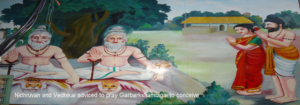

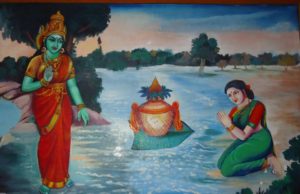
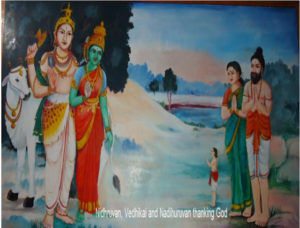
The Beauty of the Goddess:
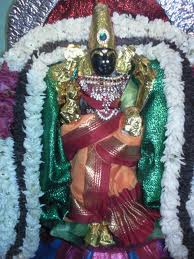
Goddess Garbarakshambika, the embodiment of motherhood, is gloriously represented by a magnificent 7-foot-tall idol within the inner sanctum of her temple, known as the Garba Graha.
This resplendent idol is adorned with exquisite kanjeevaram sarees and adorned with ornate jewellery, enhancing her divine beauty. The Goddess is adorned with an abundance of fragrant and colourful flowers, which further enhance her radiant presence. What truly captivates all who behold her is the infectious smile on her face, radiating positivity and a glimmer of hope.
For the multitude of devotees who flock to her abode, she is not merely an idol, but their last beacon of hope. Even a casual visitor cannot help but be mesmerized by the divine grace and majestic aura exuded by the Goddess in this sacred place.
Lord Mulaivana Nathar:
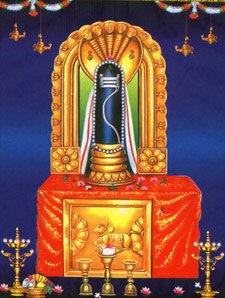
Lord Shiva, the supreme deity, is predominantly worshipped in the form of a Shiva Linga. Within the Shiva Lingam at this temple, one can still witness the impression left by jasmine creepers that once gracefully adorned it.
In ancient times, this location was a forest adorned with a beautiful jasmine garden. Hence, the Shiva Lingam at this sacred site is known as Mullaivana Nathar, meaning “Lord of the Jasmine Garden.” The Lingam of the presiding deity, Lord Mullaivana Nathar, found within the main sanctum of the temple, is a self-manifested (Swayambu) Lingam, one among the 64 in the world.
Mullai, also known as the jasmine flower, holds a special place in the heart of this deity. The sacred tree (Sthala Vriksham) of this temple is the Mullai creeper, as is customary in South Indian temples, where each temple has its designated tree mentioned in the agamas, the descriptive texts.
The Lingam of Lord Mullaivana Nathar is composed of ant hill mud, and thus, there is no traditional water abhishekam (ritualistic bathing) performed for this deity. Instead, the Lingam is gently anointed with a fragrant musk called “Punugu” in Tamil.
It is believed that worshipping the primary deity, Lord Mullaivana Nathar (Lord Shiva), has the power to cure various skin ailments. Individuals suffering from incurable diseases come to this temple, offer “Punuhu Chattam” to the Lord, and find relief from their afflictions.
The Temple Atmosphere:
Step into the temple and embrace the serene atmosphere that has gracefully prevailed for over two centuries. Despite the passage of time, the temple has retained its peaceful ambience, staying true to its roots.
By examining a photograph from the early 1800s and comparing it to a snapshot taken in 2013, one can witness the remarkable consistency in the temple’s architecture. The structural beauty has remained intact, standing as a testament to the enduring legacy of the temple and its timeless appeal.
Complementing the tranquil ambience, the temple gardens play a vital role in creating a sense of peace and serenity. These carefully nurtured gardens contribute to the overall atmosphere, adding a touch of natural beauty and tranquillity. As you stroll through the temple grounds, the sight of flourishing plants and blooming flowers enhances the peaceful experience, providing a soothing backdrop for contemplation and reflection.
The temple’s peaceful atmosphere, untouched by time, invites visitors to find solace and connect with their inner selves. It serves as a haven where one can seek spiritual solace, immersing themselves in the calm surroundings that have graced the temple for centuries.
